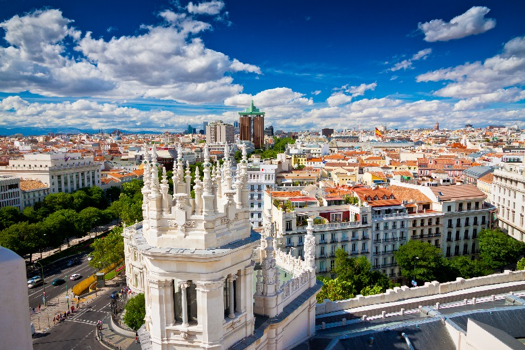Informazioni sulla città
![shutterstock_712467547]()
Barcelona’s great rival might not have the Mediterranean at its doorstep, but this doesn’t make it any less enthralling a destination. Fizzing with life and energy, Madrid is the cradle of the Spanish movida, the counter-cultural movement that exploded in the city after the end of the Francoist dictatorship. The city continues to echo this emblematic period in its openness, fashion, and underground scene. And, of course, its dedication to partying till the sun comes up.
Sight-seeing in Madrid
The Prado Museum (metro Line 1, Atocha stop) is an absolutely essential item on your itinerary. The biggest art gallery in the world, it has more than 7,000 masterpieces of Spanish painting (of which only 1,500 are exhibited) dating from the 15 th to 18th centuries. It is also well-stocked with the works of the great masters of the Italian and Flemish school. El Greco, Velázquez, Titian, Rembrandt – if you want to see them all, dedicate an entire day. If you’re a real art nut, section off a second one!
The Reina Sofía Museum (metro Line 1 Atocha stop), picks up where the Prado stops, exhibiting Spanish and international artworks from the 19th century to the contemporary era. Here you’ll find Picasso’s legendary “Guernica”, which depicts the brutal bombing of the Basque town during the Spanish Civil War.
Meanwhile, the Thyssen-Bornemisza Museum (metro Line 2 Banco de España stop), hosts one of the most exquisite private collections of paintings in the world.
Madrid’s historical buildings are as inspiring as its museums and art galleries.
Its streets are an extensive open-air museum, where you can follow the evolution of the city into a modern capital simply by walking through them. To discover old Madrid, go to the Puerta del Sol (literally, Door of the Sun) or the Plaza Mayor. Other great landmarks that give a flavour of the city’s history and beauty are the Palacio Real (Royal Palace), Casa de la Villa (City Hall), Plaza Cibeles, Teatro Real, Gran Vía, Puerta de Alcalá, Parque Retiro, and Plaza de España.
![shutterstock_501002293]()
Madrid cuisine
![shutterstock_1024600255]()
When we think of Spanish gastronomy, the first things that come to mind are usually paella, potato omelette and cold tomato soup (gazpacho). But while these dishes are served all over the country, they are far from representing the full range of Iberian cuisine.
In Madrid, meals are often large, and sauce-based dishes are at the top of the menu. Cocido madrileño (a type of stew made up of meat, sausage and chickpeas) and callos (tripe in sauce) are two of the capital’s most typical dishes.
If you like picking at small plates, go to Melo’s bar (Metro Line 3, Lavapiés stop). Don’t be put off by the aesthetics of the place, or by its crowded interior. You’ll regret you missed out! It’s a veritable institution of the neighbourhood, serving mouth-watering tapas at very reasonable prices. Their croquetas and zapatillas (giant ham and cheese melts) have a reputation for being the best in the world!
As for the sweet stuff – you can’t do Madrid without sampling the inimitable churros (long, greasy sticks of deep-fried dough) and porras (a type of churro on steroids). They are often accompanied by a café con leche (coffee with milk) or thick, hot chocolate for dipping. They have a particular appeal to those staggering home after a night out!
One of the most famous chocolaterías in the city is the Chocolatería San Gines (metro Lines 1, 2 or 3, Sol stop, or Lines 2 and 5, Opera stop). This gourmet paradise has many dedicated fans. Will you join them?
![shutterstock_657772720]()
Madrid, Spanish fashion capital
Madrid fashion is a veritable melting pot of trends and styles, and there is something for all tastes and budgets.
Gran Via is the main street, and between the metro stations of Gran Via and Santo Domingo you’ll find stores like C&A, H&M, Nike, Zara, Oysho, Primark, Pull&Bear, Clarks and others. Shopping addicts will be sure to leave with their arms loaded!
![shutterstock_474514756]()
In the Salamanca neighbourhood, the streets of Claudio Coello, José Ortega y Gasset and Serrano make up the “golden kilometre” of chic Madrid. Here, prestigious designer brands such as Chanel, Agatha Ruiz de la Prada, Carolina Herrera, Gucci, Armani and Louis Vuitton all display their most recent collections in their windows.
More alternative shops and independent boutiques are based around the axis of Malasaña – Fuencarral – Chueca, often squeezed between an abundance of tattoo parlours. Vintage fans will find heaven in the Templo de Susu (metro Lines 1 and 10, Tribunal stop or at Popland. Here you can plunge straight into the legacy of the movida, Madrid’s explosive 1980s counter-cultural scene.
If you like picking through bric-a-brac and second-hand clothes in search of a bargain, then go to the Rastro flea market. It is held in and around the street of Ribera de Curtidores every Sunday and bank holiday. There are few places as typically madrileño as this. Those who arrive before 11.00am can wander through the stalls freely, but if you prefer the more bustling atmosphere characteristic of the market, get there between 12pm and 3pm (when it closes).
Getting around Madrid
The Spanish capital has a vast public transport network. However, most of the tourist zone is concentrated in the heart of the city, so you can access most sights by foot without wearing yourself out.
The Madrid metro is one of the oldest in Europe (after those of Paris and London) and has 13 lines that will take you to almost any corner of the city. The advantage of the metro is its speed and the fact that it runs from 06.00am to 01.30am every day. It’s also free for children under 4.
The bus is an excellent alternative to the metro if you’re not in a rush, and especially if you want to admire the city on your journeys. The network is dense, practical and particularly fast thanks to the dedicated bus lanes. It goes from 6am to 11.30pm, after which time the night buses or búhos (owls) take over. Two lines serve all neighbourhoods of Madrid. On weekdays they go every 35 mins from 11.45pm to 4am (with the last one at 5.10am). Fridays, Saturdays and nights before bank holidays they go from 11.45pm to 5.30am, every 15-20 mins from the Plaza de Cibeles.
You can buy several different types of day tickets and season tickets in metro stations, either at the ticket machine or from the ticket office. Some newspaper kiosks on the street also supply them. Both the metro and bus function on the same system of tickets and fares. However, the “cercanía” trains that serve the Madrid suburbs have their own fare system.
- Single tickets: €1.50 per journey in Madrid centre (Zone A) by bus, by metro or on the ML1 (Tramway Line 1). You pay an extra €0.10 for each of the next five stops, to a maximum of €2.00. No panic, the ticket machine or ticket seller will tell you how much you need to pay.
- The Metrobus pass gives you ten trips, which can be used by several people at the same time, and is valid for all of inner Madrid (Zone A) by bus, metro or Tram Line 1, and costs only €12.20. Be warned, though. If you buy it from the airport, you’ll have to add a €3 airport supplement per person.
- Tourist passes (abonos turísticos) are available for 1, 2, 3, 5 or 7 days. There are two versions and prices depending on the zones covered.
The A fare is for those who only want to get around the city centre. It covers the metro, ML1, buses and urban <i>cercanías</i>. Respectively, they cost €8.40, €14.20, €18.40, €22,60, €26.80 €35.40 (there is a reduction of 50% for under 11’s).
The T fare includes all urban transport within the community of Madrid (thus including the ML2 and ML3 tram lines, Cercanías lines and intercity buses going to Àlcala de Henares, San Lorenzo de El Escorial and Anranjuez. The buses extend to Toledo, Cuenca and Guadalajara: respectively costing €17, €28.40, €35.40, €50.80 and €70.80 (50% reduction for under 11s).
Click here to access the metro map of Madrid and its fare zones. The website of Madrid metropolitan trains allows you to consult an interactive map of public transport as well as find the best route for your journey. You can also check the timetables of each line and, even better, get real time status updates for the entire system.
![shutterstock_1105398194]()
Madrid at night
We know that the Spanish can party to the max. But with Madrid it’s on a whole new level.
The main artery of the city is Gran Via (Line 2, Santo Domingo stop or Lines 3 and 5 Callao stop). Here you can enjoy a pre-dinner drink on the rooftop terraces of the Ada or Urban hotels, while taking in the spectacular Spanish sunset.
When night has fallen, people flock to the Rialto Movistar, Príncipe, Lope de Vega, Compac Gran Vía and Caser Calderón theatres to watch plays and musicals. The restaurant-cabaret Gula Gula deserves a special mention due to its outrageous drag shows, which will put a smile on even the soberest face.
n the Malasaña neighbourhood (metro Lines 3 and 10 Tribunal or Plaza España stops, Line 2 Noviciado stop) you can experience the nostalgia of the movida in a host of alternative bars and venues. Rock and punk artists hold sway here, each one more underground than the next. In Ojala, have a drink with your feet in the sand while enjoying organic snacks and watching animated films projected onto the stone walls. Pretty original, right. Tupperware goes for a more kitsch vibe, as does Vía Láctea (literally, the Milky Way), where the walls and ceilings are covered in posters and signs straight out of the 80s. The belting rock music will definitely leave your ears ringing.
If you’re not ready to stop after your tour of Malasaña, head to Chueca, the capital’s gay neighbourhood. It is the most open and cosmopolitan part of Madrid, welcoming people of all ages and predilections. Fun is guaranteed any night of the week – right up to sunrise.
Those who love clubbing and pulling all-nighters will be fully at home in Madrid. There are many late night venues, and they generally don’t close their doors until the early hours of the morning. One of the biggest club is Teatro Kapital (metro Line 1 Atocha stop), which is spread over a whopping 7 floors, with different music played in every room. Siroco, (à Malasaña), is a temple for alternative music, with an eclectic programming that means it’s possible to dance to techno one night and reggae the next.
Be sure to check out the website Guía del ocio to find out all about what’s going on in Madrid every evening!
![shutterstock_546048400]()














